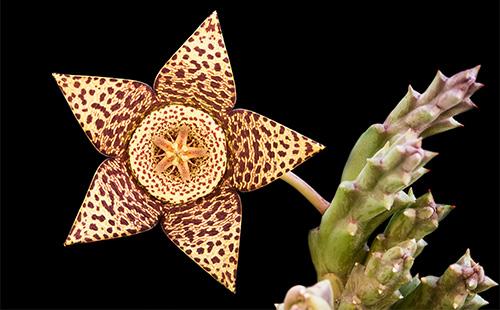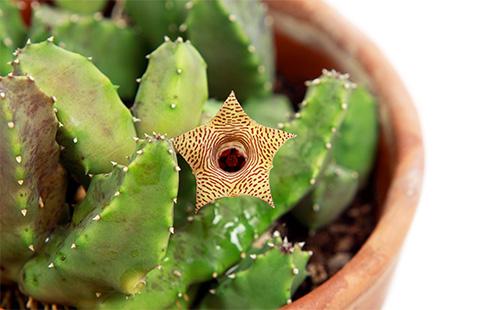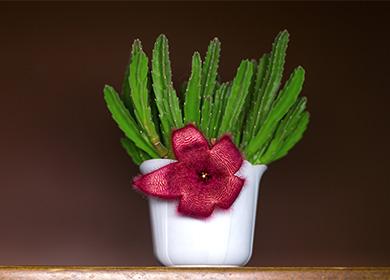The content of the article
Stapelia belongs to the kurtov family. The natural habitat is predominantly South Africa. A flower settles on the slopes in the mountains and near ponds. Like many other succulents, slipway is unpretentious, for a long time can do without care. Therefore, it can be advised to busy people and beginners in floriculture.
Description
Perennial small succulent. An adult plant can be only 10 cm. Sometimes it grows up to half a meter, in an artificial environment it is very difficult to achieve active growth.
The root system is located on the surface, very weak. The plant itself consists of highly branched processes, the skin on the shoots is smooth. The shoots are slightly curved, rather thick. Coloring - saturated green with the addition of a pinkish or yellowish color. The shoots of most varieties are covered with a whitish waxy coating. The number of faces is from four to six. Small ridges stand out along the ribs.
It blooms in summer. Large buds develop at the base of the stapelia or on its crown. The flower rests on a separate elongated peduncle. Flowers are flattened, of five petals or bell-shaped. They are small - about 5 cm, and large - up to 30 cm. The petals are dense, juicy, in the center they form a fused funnel. The flowers are completely or only their edges are covered with glandular villi. The color of the pile is white or faded — pink. The color of the flowers is very different - from lemon to burgundy.
Known Varieties
The genus includes more than 50 species. For home growing adapted the most decorative and interesting species.
- Large flowered. The shoots are green, with four faces. Branching starts from the bottom. Closer to summer an elongated peduncle is formed in the lower part of the stapelia. He carries a flower resembling a starfish. The flower is quite large - in some cases reaches 25 cm. The color is often burgundy or purple, the petals are covered with a silvery long pile. Blossoms not for long - no more than five days. Popular due to its mild odor.
- Motley. The stems are bright, fleshy. The bush is close in form to a perfect circle. Ribs are smooth, with bent teeth. A miniature variety - the size is rarely more than 10 cm. It blooms in the summer months. The flowers are motley, bright up to 8 cm. The color is cream or yellowish with prominent burgundy or brownish spots. Corolla flattened, with a protruding ring framing the triangular petals. Unpretentious variety with a pronounced fetid odor.
- Star-shaped. The stems are tetrahedral. A compact plant up to 20 cm. The skin of the stems is smooth with faded purple or pinkish stains. The teeth are very small. Flowers are formed at the bottom, often collected in small groups of three. Pedicels are elongated, thin. The corolla in the shape of a star is relatively small - up to 8 cm. The villi are present only from the sides, the rest of the flower surface is smooth, glossy, slightly tuberous.The most common colors are yellow, red and orange.
- Giant. The shoots are long, juicy with pronounced longitudinal grooves. It differs in the largest flowers up to 35 cm. Flowers are pubescent, five-petalled. Coloring is mainly yellowish-cream with thin burgundy short stripes. The tips of the petals are elongated, narrow, sometimes spiraling. The smell is very sharp, reminiscent of rotten meat.
- Golden purple. Compact plant up to 10 cm. Buds are formed in groups, collected at the top of the stem. The flowers are not large - their size rarely exceeds 4 cm. They are similar in appearance to flat starfish. The surface is yellowish or light green in color; the center is in contrasting purple or white. The pubescence is predominantly in the center. The only variety with a pleasant but faint odor.

If not blooming
Pretty common problem. There may be several reasons.
- Big pot. Stapelia blooms better in a slightly cramped pot. In a large amount of substrate, it begins to intensively build up shoots.
- Lack of rest period. The flower buds of the stapelia are laid during the period of hibernation. If at this time it is kept warm, flowering does not occur.
- Young instance. Young slipways rarely bloom. They need to mature. Flowering age varies in different varieties. On average, stapelia blooms in the third or fourth year.
To achieve flowering, remove the old shoots, transplant into a smaller pot. In winter, be sure to arrange a vacation - maintain the temperature at 12-15 ° C, reduce the frequency of watering to one to three times a month. After bud formation, do not disturb the plant.
Basic care
Growing stapelia does not require special skills. But a number of requirements for microclimate and care must be adhered to.
- Lighting. Stapelia loves bright lighting, but burns remain from the sun. The sun can only be set in spring or autumn. Place better on the west or east window. On hot days they shade. After being kept in a shaded place, they gradually accustom to light.
- Temperature. The plant is thermophilic. The optimum summer temperature for stapelia is 22-26 ° C. In the fall, he feels rather well at a temperature of about 15 ° C. In winter they keep cool - 12-14˚С. Further lowering of the temperature is not allowed.
- Watering. In warm time, throughout the entire growing season, the slipway is watered as the soil dries. In summer, watering is regular and quite plentiful, in the fall - moderate and not frequent, in winter - minimal. The need for watering in the winter is determined by the state of the plant. If the leaves of the slipway start to wrinkle, it's time to water. Prolonged drought affects negatively - the roots begin to die out gradually.
- Humidity. The humidity level in the room does not play any role. This is a succulent plant that stores enough moisture. Spraying is not necessary.
- Top dressing. It is recommended to use special fertilizers for cacti. Additionally, you can feed potash fertilizers. Potassium - strengthens the immunity of stapelia, makes it more resistant to disease.
- The soil. Use sandy soil. The simplest composition is a mixture of turf with earth. You can use ready-made soils for succulents, but crushed coal must be added to them.
- Transfer. Held once a year. For adult plants, rarer transplants are permissible. The pot is wide and shallow. After the "relocation", a temporary lack of watering, moderate lighting and temperature are necessary.
Breeding methods
Stapelia propagation is practiced by cuttings, seeds and dividing the bush. All methods are quite effective.
- Seeds. Seeds ripen for a long time - at least a year. They sprout quickly. Sow seeds in a light substrate with a predominance of sand, moisten, cover with a film. The first shoots appear within a month. When the seedlings grow up, they can be planted in separate small pots. Subsequent transplants as they grow by transshipment. They work very carefully, try not to injure the delicate root system.
- Cuttings. Cutting cuttings is better from old shoots - they take root more easily. During the day, the cuttings wilt, then planted. As a substrate, take a mixture of peat chips and sand. There is no need to cover. Maintain stable humidity. Roots appear pretty quickly. After full rooting, seedlings are planted in separate pots.
- Dividing the bush. Simultaneously with the transplant, you can divide the bush. They divide carefully, trying not to smash, not damage the roots. Each part is planted in a separate container.

Diseases and Pests
Stapelia is considered a persistent succulent - problems are extremely rare. Sometimes affected by pests, with regular waterlogging, you can encounter a disease such as rot. All the main problems, their solution and treatment are described in detail in the table.
Table - Problems of growing stapelia
| Problem | Signs | Elimination |
|---|---|---|
| Mealybug | White cotton-wool-like formations | Repeatedly treated with drugs "Fitoverm" or "Actellik" |
| Spider mite | - Slowdown of growth; - light spots on the shoots; - thin, small cobweb | - Increase humidity in the room; - processed by means of "Aktara" or "Aktellik" |
| Root rot | - Softening and subsidence of shoots; - root decay | - Watered with the drug "Previkur"; - transplanted into fresh and sterile soil; - carry out cuttings in case of the death of the slipway |
| Light, elongated shoots | - Lack of light; - lack of nutrition; - potassium deficiency | - They are fed with a preparation containing potassium; - adjust the conditions of care |
| Lack of flowering | - Spacious pot; - young age; - wintering in warmth | Eliminate care errors |
| Brownish spots on the stems | Sunburn | In hot weather they shade |
Stapelia can be called an ideal plant for offices and busy people. If the smell from the flower seems completely unpleasant to you, then during flowering the plant can be rearranged on the balcony.

